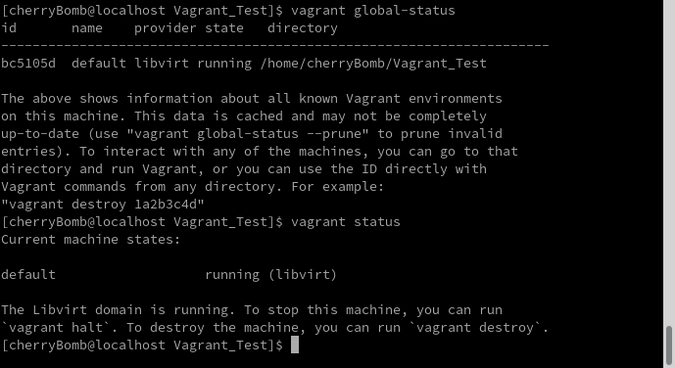
=> default: Setting the name of the VM: our-awesome-project_default_1610932671808_5447 => default: Checking if box 'generic/ubuntu2004' version '3.1.22' is up to date.
Vagrant commands mac#
=> default: Matching MAC address for NAT networking. => default: Importing base box 'generic/ubuntu2004'. => default: Successfully added box 'generic/ubuntu2004' (v3.1.22) for 'virtualbox'! => default: Adding box 'generic/ubuntu2004' (v3.1.22) for provider: virtualboxĭownload redirected to host: vagrantcloud-files-production.s3.ĭefault: Calculating and comparing box checksum. => default: Loading metadata for box 'generic/ubuntu2004' => default: Box 'generic/ubuntu2004' could not be found. Vagrant provides a lot of documentation, which is very helpful to get an idea how things work together.Bringing machine 'default' up with 'virtualbox' provider. I will ensure to address these in a future article. You can also set up more complex setups with different networks or additional disks. You can do much more, like snapshots, suspends, manipulate boxes or add provisioners to your Vagrantfile. gitignore file, so your local cache, images and snapshots are excluded from the repository. They also serve as a documentation for your environment setup. These files can be shared in a repository and can be easily used, if all the developers are having Vagrant on their machines. But what about multiple VMs, with different OS? This can be achieved with a quite simple configuration like the below: nfigure("2") do |config|Ĭonfig.vm.define "fedora33" do |fedora33| Running a single VM is not something that really helps with development. These commands should help to get things going. # Or read config to the same with your regular client # Check global status (for the entire system) If you know Docker or Podman, you will see some similar behavior.

Interacting with Vagrant machines is quite easy, too. After a minute or two (including the download) the machine will be ready, and you can continue to use some commands. The very first initialization will take some time, since a Vagrant Box will be downloaded from the Vagrant Cloud. nfigure("2") do |config|Īnd we can already start our first machine. The Vagrantfile should have content like this. VagrantfileĪfter the installation, we can already create the first Vagrantfile for testing and demonstration. $ sudo systemctl enable -now rviceĪfterwards, you will be able to create your first Vagrantfile.
Vagrant commands install#
$ sudo dnf install vagrant vagrant-libvirt Installing vagrant is as easy as: # Install vagrant and libvirt dependencies If the command does not provide any output, your machine may not support virtualization, or you have to enable it in your BIOS/UEFI. The above is the output of an Intel based machine and may be different for other CPU technologies. Precheckįirst, you should check if your machine does support virtualization. The guide is tested on Fedora 33 with Vagrant 2.2.9. For this Article, we will install Vagrant with libvirt (KVM) on a Fedora Workstation. For installation options, you should have a look at the documentation. If you want to have your development environment reproducible and transportable on your workstation, you should try Vagrant.

Vagrant commands portable#
Vagrant by Hashi Corp enables users to create and configure lightweight, reproducible, and portable development environments.


 0 kommentar(er)
0 kommentar(er)
